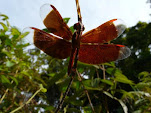A milestone today - our first ringing session of the year (non-garden) and somehow there's a need to include Sabina in this experience. I set off early with David and Peter, opening the nets early enough to make it worthwhile, whilst Na brought the youngest member of the group along at about 10 (bang-on 10 in fact: German punctuality strikes again!).
It was a typical day for this time of year: a couple of feeders are occasionally topped up by one or another of us so that there is some focus to the birds during the winter, and consequently much of the catch is Blue, Coal and Great Tits. However, we continue to accrue some useful information about the number of
Poecile tits on site: three Willow Tits caught, two recaptures and one new bird; all of them last year's juveniles.
 |
| Willow Tit (Poecile montana kleinschmidti). A rather small and neat bib on this bird, but you can see many of the key features which indicate Willow rather than Marsh: clean white cheeks, strong bill (and longer than Marsh) with no clear white spot at the base of the upper mandible, a rather dull and extensive black cap, a hint of a pale panel in the wing - and if you look carefully, a very different tail pattern than you'll see on Marsh. |
 |
| A closer look at that tail - notice that the outermost feathers are rather shorter than the innermost, and that there is a clear view of most of the feather tips at regular intervals between the extremes. On Marsh, this would not be the case; almost all the feathers being similar in length except for the outermost pair, which are rather shorter. |
 |
| A bit overexposed, but here you can see that nice pale panel in the wing... as well as seeing how long the cap is. |
We also caught two new Marsh Tits, a female Reed Bunting and an unusually-marked male Great Spotted Woodpecker. The woodpecker appeared to be one of last year's young as well, with new glossy black greater coverts and mantle feathers contrasting very strongly with a set of unusually pale outer greater coverts and primary coverts. You might also be able to pick out in the picture that the secondaries also appear rather washed-out.
 |
| Young male Great Spotted Woodpecker (Dendrocopos major). Those pale wing feathers stand out a mile in the hand, but would be almost impossible to see in the field, I think. Would be fascinating to catch him again after the next moult and see what's happened there. |
 |
| Female Reed Bunting (Emberiza schoeniclus). The amount of wear on the tail in particular suggested to us that this was a bird born last year. |








1 comment:
The cute little bird is looking so beautifull.I love these type of pictures of birds.....
Post a Comment